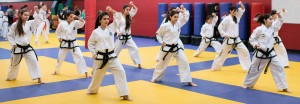
It is seen that with the advent of modern technology, physical education has not been given much thought in the past. Instead of spending time outdoors in fresh air, children these days prefer to sit in the company of computers or watch television. Pressure of studies, ambitious academic programmes of the schools, ever growing number of books etc. have also made it difficult for them to indulge in sports activities.
The present day picture of education is young students carrying heavy satchels to schools, spending most part of the day in the class room and coming back home to have another heavy dose of home work. This is not only taking heavy toll on the health of the children, but is also affecting their creativity.
Physical activity may influence the physical health of girls in two ways. First, it can affect the causes of disease during childhood and youth. Second, physical activity could reduce the risk of chronic diseases in later life. A number of ‘adult’ conditions, such as cancer, diabetes and coronary heart disease, have their origins in childhood, and can be aided, in part, by regular physical activity in the early years. Also, regular activity beginning in childhood helps to improve bone health, thus preventing osteoporosis, which predominantly affects females.
Adolescent girls are particularly vulnerable to anxiety and depressive disorders: by 15 years, girls are twice as likely as boys to have experienced a major depressive episode. Research suggests two ways in which physical activities can contribute to mental health in girls. Firstly, there is fairly consistent evidence that regular activity can have a positive effect upon girls’ psychological well-being. Secondly, research has indicated that physical activity can contribute to the reduction of problematic levels of anxiety and depression. A range of evidence suggests that for many girls, sports and physical activities are positive features of their academic aspirations and achievement. More recent studies have found improvements for many children in academic performance when time for physical activity is increased in their school day.
The children, especially in the initial six years, should be allowed to grow with nature till they grow strong in the atmosphere of freedom and realize the importance of education and knowledge. It should be realized that along with academics, extra curricular activities, especially sports, are vital for the overall growth of the children and for better performance. Our main aim should be to make children, both boys and girls, not robots but human beings with mind and heart bustling with enjoyment and enlightenment.













